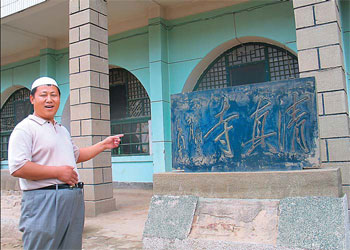Believers and their unfettered choice of faith
By Ren Ke and Feng Guo (China Daily)
Updated: 2007-11-15 10:55
Updated: 2007-11-15 10:55
Attending mass at Hutoumao Catholic Church every Sunday has been an indispensable part of Wang Jian's life since 1998. An administrative staff in a State-owned local transport company, Wang is one of the 1,000-odd Catholic residents of Yan'an in Shaanxi Province.
Qiao'ergou Catholic Church, the first in the city, was built in the 1930s. Now the local government plans to build a new church closer to the city center. The Qiao'ergou Catholic Church is on the Yanhe River. The Spanish missionary vacated it after the Red Army reached Yan'an in 1935 following the Long March. Yan'an was the headquarters of the Communist Party of China from 1935 to 1947.
Imam Han Chuanjin points to a stone tablet in his mosque in Yan'an that carries an inscription by Chairman Mao Zedong. After the death of Lu Xun, one of China's greatest contemporary writers, in 1936, the church was turned into Lu Xun Art Academy. The academy's stone building was listed as a national-level cultural relic site in 1996. Now it is being turned into an art museum.
The Yan'an Bureau for Religious Affairs (BRA) says more than 6,000 square meters of land has been allocated for the new church. The land at present is used as a farmers' market, and is closer to the city center than the old church. The BRA has reportedly signed the land acquisition contract with the village and is trying to persuade the farmers to relocate.
"We have to take into account the interests of believers and non-believers both," says BRA Director Huang Qingling. "The construction work will start next year after the farmers are relocated." More than 2 million yuan ($260,000) has been sanctioned for the new church. And though the design is still under discussion, it can accommodate more than 300 people after completion.
Yan'an is like most other Chinese cities where there's a dearth of land for construction. That's why the new church can't be built in the center of the city. Wang Jian, a 45-year-old Catholic says: "A church in the center of the city, or near the square, would have been better. But all the same, I can't wait to go to the new church."
The new Catholic Church is not the only symbol of religious freedom in China, for a Protestant church and a mosque have also been built in recent years in the cradle of Communist revolution in the country. On a mountainside not far to the south of the downtown area sits the South Christian (Protestant) Church, marked by a Latin Cross and overlooking the road that leads to the center of the city. It was built in 2002, the same year Liu Liqin began studying in a Bible school in Xi'an, capital of Shaanxi Province.
|
|
|
||
|
||
|
|
|
|


